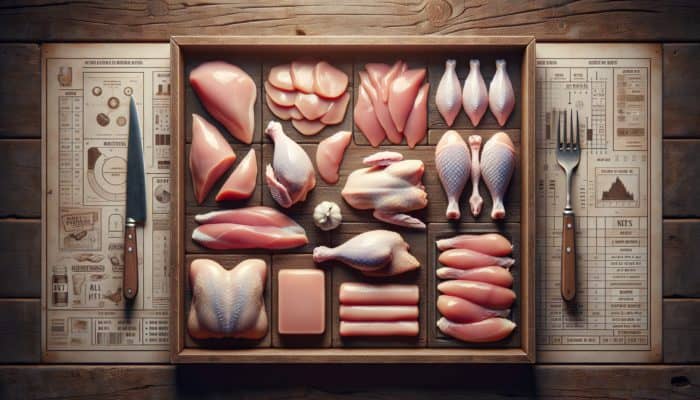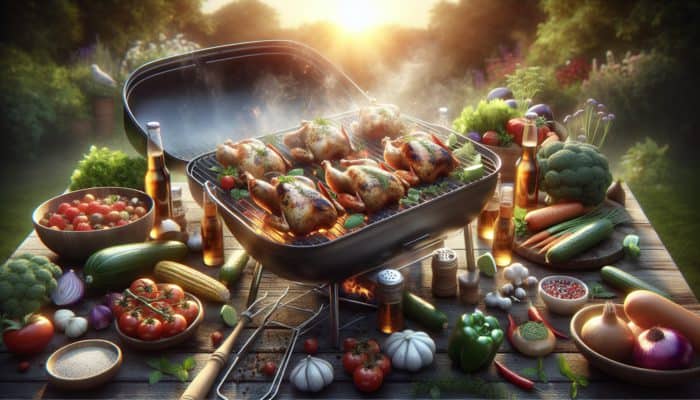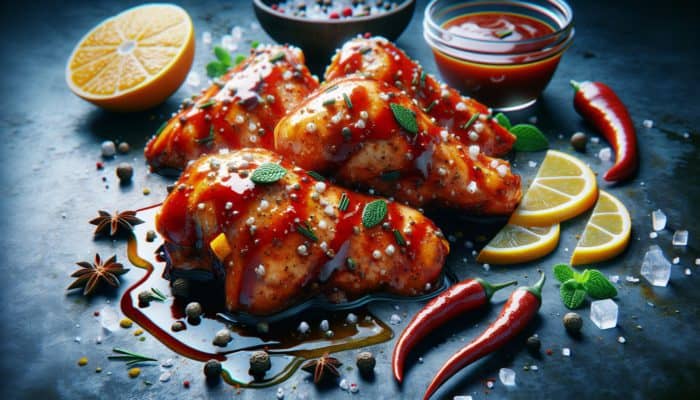Master the Art of Grilling: Selecting the Perfect Chicken for Irresistibly Succulent Results
To achieve the ultimate in grilled chicken perfection, it's essential to understand the nuances involved in selecting the right type of chicken that will guarantee juicy and flavourful results. The quality and specific cut you choose have a monumental impact on the overall taste and moisture of your grilled dish. With a vast array of options available in the U.S. chicken market, being able to discern the superior selections is paramount. Opting for fresh, high-quality chicken is vital for ensuring that your meal remains succulent and brimming with flavour throughout the grilling process. By delving into the subtleties of chicken selection, you establish a robust foundation for your grilling triumph.
Spotting Fresh Chicken Cuts for an Unforgettable Grilling Experience

To ensure that your grilled chicken is bursting with juiciness and flavour, it is imperative to start with the freshest chicken cuts available. Fresh chicken should display vibrant colours and a firm texture that signifies its quality and freshness. Chicken breasts should ideally exhibit a light pink hue, while thighs and wings boast deeper, richer tones. When handling chicken, a gentle press should reveal a firm yet slightly springy texture. If the chicken feels mushy or slimy, it’s wise to opt for a fresher alternative to guarantee the best grilling experience.
High-quality chicken is frequently sourced from local farms, where chickens are raised under optimal conditions. Always select chicken that has been stored at appropriate temperatures and avoid any packages displaying frost or ice crystals, as these may indicate freezer burn and compromised quality. Familiarising yourself with the USDA grading system can also prove advantageous; chicken labelled as ‘Grade A’ signifies higher quality with no visible defects, aiding you in making an informed decision for your grilling adventures.
Exploring Different Chicken Types for Superior Grilling Results
To fully savour the grilling experience, it’s crucial to understand the various chicken cuts available and how each performs on the grill. Chicken breasts are lean and cook quickly, making them more prone to drying out if overcooked. In contrast, thighs and drumsticks consist of darker meat with a higher fat content, which makes them more forgiving during grilling as they tend to retain moisture even with prolonged cooking times. Chicken wings are also superb for grilling, especially when marinated, enhancing both flavour and juiciness.
As you prepare for your grilling adventure, pay careful attention to the thickness of each cut. Thicker pieces will require longer cooking times, whereas thinner cuts will cook more rapidly. A useful guideline is to maintain a consistent temperature while adjusting your grilling time based on both the thickness and type of meat. Mastering this knowledge will empower you to grill with confidence, ensuring consistently juicy and tender results with every cook.
Are You Ready to Ignite Your Grilling Journey?
Why Sourcing Quality Chicken from Reliable Suppliers Matters
Acquiring chicken from reputable suppliers is crucial for ensuring top-notch quality. Local butchers and farmers' markets typically offer fresher selections compared to mass-produced chicken found in grocery stores. These providers often adhere to superior practices regarding animal welfare and frequently provide options that are organic or free-range. Knowing the origins of your chicken not only enhances its flavour but also enriches your overall dining experience, fostering a deeper connection with the food you consume.
When shopping at a butcher shop, don’t hesitate to ask questions. A knowledgeable butcher can share valuable insights regarding the chicken's origins, the conditions under which it was raised, and the best methods for preparation. Engaging in this dialogue empowers you to make informed decisions, ensuring that you receive the best product for your grilling adventures. Inquire about farming practices, the chickens’ rearing conditions, and whether they were administered antibiotics or hormones throughout their growth cycle.
Benefits of Choosing Organic and Free-Range Chicken for Grilling

Opting for organic or free-range chicken can significantly elevate the flavour and texture of your grilled dishes while aligning with ethical eating practices. Organic chickens are raised without synthetic pesticides or fertilizers and are fed organic feed, which positively influences their flavour profile. Conversely, free-range chickens benefit from access to outdoor spaces, allowing them to express natural behaviours, which results in richer-tasting meat that you’ll appreciate.
In the United States, a growing number of consumers prioritise the welfare of farm animals. Choosing organic or free-range chicken reflects this conscientious approach to food sourcing. Many local farms offer these options, and purchasing directly from these sources can lead to discovering exceptional flavours that are often absent in conventionally raised chickens. Although these ethical choices may come at a higher price, consider this an investment in quality, taste, and sustainable practices that resonate with your values.
Essential Preparation Steps for Chicken Before Grilling
Preparation is as important as selecting the right chicken when it comes to ensuring that your grilled chicken retains its moisture and flavour. Each step in the preparation phase significantly influences the final outcome. Techniques like brining and marinating can profoundly affect the juiciness and flavour of your grilled chicken, effectively setting you up for success on the grill.
Infusing Moisture and Flavour into Chicken Through Brining
Brining chicken is a time-honoured technique designed to infuse moisture and flavour into the meat, ensuring it remains juicy during grilling. A basic brine consists of water, salt, and sometimes sugar, along with optional herbs and spices to add complexity. Soaking the chicken in this solution for at least 30 minutes, but preferably several hours or overnight, can yield optimal results. The salt in the brine breaks down some of the proteins in the chicken, allowing it to absorb water and flavour, which ultimately helps retain moisture throughout the grilling process.
In the U.S., you can elevate your brining experience by incorporating local flavours such as apple cider or citrus juices, enhancing the overall taste while contributing to the chicken's tenderness. After the brining process, thoroughly rinse the chicken to remove any excess salt, and then pat it dry with paper towels to ensure even cooking. This crucial step aids in achieving a beautiful crust on the grill while keeping the meat moist and flavourful throughout.
Maximising Flavour Profiles with Chicken Marinades

Marinades have the transformative power to elevate grilled chicken into a gourmet masterpiece. A well-crafted marinade combines oil, acid, and various flavouring agents—the perfect trifecta for enhancing taste and moisture retention. Oils help lock in moisture, while acids like vinegar or citrus juice tenderise the meat, and a variety of spices and herbs infuse bold flavours that tantalise the palate.
For an American twist, consider incorporating regional flavours such as barbecue sauces, citrus-based marinades, or southwestern spice blends. Marinate your chicken for a minimum of 30 minutes; however, for maximum flavour absorption, consider marinating overnight. This allows the flavours to meld beautifully, resulting in an unforgettable grilled experience. Remember to discard any leftover marinade that has come into contact with raw chicken to prevent cross-contamination and ensure food safety.
The Importance of Drying Chicken Before Grilling
Although it may seem counterintuitive, patting your chicken dry before grilling is a critical step that should not be overlooked. Excess moisture on the surface of the chicken can hinder browning and create steam rather than achieving a proper sear, leading to less flavourful outcomes. Using paper towels to gently dab the chicken will remove excess moisture while also preventing flare-ups on the grill, which can disrupt the cooking process.
This step is particularly important if you’ve brined or marinated the chicken, as these processes can add additional liquid to the surface. Once the chicken is dry, generously season it with salt, pepper, and any additional spices to ensure that every bite is packed with flavour. Properly preparing the chicken's surface enhances its texture and contributes to forming a gorgeous, golden-brown crust that is both visually appealing and delicious.
Optimising Your Grill Setup for Exceptional Results
The configuration of your grill can greatly influence your chicken grilling experience. Proper grill preparation regulates cooking temperatures, enhancing both safety and flavour. Understanding your grill’s mechanics will enable you to cook chicken to juicy perfection consistently, regardless of the type of grill you are employing.
Selecting the Right Grill for Your Chicken Grilling Needs
When it comes to grilling chicken, your grill choice largely depends on personal preference and available resources. Gas grills offer remarkable convenience, allowing for quick heat adjustments and maintaining steady temperatures. In contrast, charcoal grills provide a classic smoky flavour that many grilling enthusiasts cherish. Electric grills serve as a versatile option for those residing in apartments or areas where traditional grilling methods may not be feasible.
Each grill type possesses its distinct advantages. Gas grills heat up rapidly and are user-friendly, making them perfect for busy weeknights. Charcoal grills, while requiring more time and effort to set up, impart a unique flavour profile that is hard to replicate. Electric grills, despite lacking the depth of flavour, are ideal for simplicity and ease of use. Assess your grilling needs and select a grill that aligns with your cooking style and lifestyle preferences.
The Critical Role of Preheating Your Grill
Preheating your grill is a non-negotiable step for effective grilling. A properly preheated grill guarantees that your chicken cooks evenly and achieves that coveted sear. Whether you're using a gas, charcoal, or electric grill, establishing the right temperature is critical for success. For chicken, a medium-high heat range of about 375°F to 450°F is ideal for achieving a crisp exterior while cooking the meat thoroughly without drying it out.
Plan to preheat your grill for at least 10-15 minutes before placing the chicken on it. This process allows the grill grates to reach the optimal temperature, helping to prevent sticking and resulting in beautiful grill marks. Utilise a grill thermometer to verify that the grill has reached the desired temperature, ensuring optimal results each time you cook.
Creating Effective Temperature Zones for Grilling Chicken
Establishing temperature zones on your grill can revolutionise your chicken grilling technique. By creating direct and indirect heat zones, you can control the cooking process and prevent the chicken from overcooking. Direct heat is perfect for searing the chicken, forming that sought-after crust, while indirect heat allows for more gradual cooking, which is ideal for thicker cuts.
For gas grills, activate half of the burners to create a hot zone, leaving the other half off for indirect heat. For charcoal grills, gather the coals on one side of the grill to achieve a similar effect. This setup enables you to sear the chicken over direct heat and then transfer it to the cooler side to finish cooking without the risk of drying out. Mastering these grill dynamics will significantly enhance your chicken grilling skills.
Grilling Techniques for Perfectly Cooked Chicken
Grilling chicken is not solely about the setup; the techniques employed during the grilling process are equally paramount for achieving delightful results. Mastering these methods can help you retain moisture, infuse flavours, and create mouthwatering grilled chicken that will impress your family and friends.
Understanding Direct vs. Indirect Grilling Methods
The choice between direct and indirect grilling has a considerable impact on the outcome of your chicken. Direct grilling involves placing the chicken directly over the heat source, which is fantastic for achieving a delicious sear on the exterior. However, this method can quickly lead to overcooked or dried-out meat if not monitored closely.
Conversely, indirect grilling is preferable for larger cuts or chicken pieces that require longer cooking times. By positioning the chicken away from the heat source, you allow it to cook slowly, retaining moisture and flavour. This technique is particularly beneficial for bone-in cuts, such as thighs and drumsticks, where the meat is more forgiving and thrives under the tenderising effects of slow cooking. Balancing these two grilling methods will result in perfectly cooked chicken every time.
Flipping and Rotating Chicken for Even Cooking
Regularly flipping and rotating your chicken on the grill is essential for ensuring even cooking and minimising the risk of burning. Chicken can develop hot spots on the grill, and by turning it frequently, you promote uniform browning and prevent any one side from becoming charred. A general guideline is to flip the chicken every 4-5 minutes, allowing it to develop a delightful crust without overcooking.
When grilling smaller pieces, such as wings or thighs, consider rotating them around the grill to expose each piece to varying heat levels. This technique not only enhances the flavour through improved grill marks but also helps maintain moisture by ensuring consistent cooking throughout all chicken cuts. Mastering the art of flipping and rotating can be the key to achieving juicy, flavourful chicken.
Utilising a Meat Thermometer for Perfectly Cooked Chicken
Employing a meat thermometer is vital for achieving perfectly grilled chicken. The USDA recommends cooking chicken to an internal temperature of 165°F to ensure it is safe to eat. However, removing the chicken from the grill at this temperature can often lead to overcooking, as it continues to cook slightly while resting.
For optimal results, consider removing the chicken from the grill when it reaches an internal temperature of approximately 160°F, then allowing it to rest until it attains the ideal 165°F mark. This technique prevents the chicken from drying out while ensuring you serve safe and delicious meat to your guests. Understanding the significance of accurate temperature management will elevate your grilling proficiency.
The Essential Art of Marinating and Seasoning Chicken
The importance of marinating chicken for grilling cannot be overstated. A well-seasoned chicken can shine on its own, while a good marinade infuses it with a depth of flavour that transforms the dish into something extraordinary. Whether you choose a simple mix of salt and pepper or a more intricate blend of spices, ensure that the seasoning is applied generously.
When marinating, allow the chicken to soak for at least 30 minutes; overnight marination will yield even more intense flavours. Use a combination of herbs, spices, and oils to create a balanced marinade that tantalises your taste buds. Experiment with different flavour profiles, from tangy citrus to rich barbecue sauces, to discover your favourite combinations. Proper seasoning is vital to achieving a mouthwatering grilled chicken that will leave you and your guests raving.
Managing Grill Temperature for Juicy Chicken
Maintaining a consistent grill temperature is crucial for grilling chicken that is both juicy and flavourful. Fluctuating temperatures can lead to uneven cooking and the dreaded dried-out chicken. Utilise grill thermometers to monitor temperatures and adjust the grill vents accordingly for charcoal grills, or manage the burners on gas grills to maintain the desired heat level.
During the grilling process, keep a watchful eye on any flare-ups, which can quickly result in burnt chicken. If flare-ups occur, move the chicken to the cooler side of the grill until the flames subside. Consistently managing the grill temperature ensures that the chicken cooks evenly, resulting in every bite being as juicy and flavourful as the last. Effectively managing your grill temperature can be the key to your success in grilling.
Timing Your Cooking for Optimal Juiciness in Chicken
Cooking chicken to perfection and maintaining the right temperature requires meticulous attention to timing. Each cut has different cooking requirements, and understanding these differences is paramount for avoiding dry, overcooked meat. Keeping a close watch on the cooking process will yield the best results.
Adjusting Cooking Times Based on Chicken Thickness
The thickness of your chicken cuts plays a critical role in determining cooking time. Thicker cuts, such as chicken breasts, will naturally require more time on the grill compared to thinner pieces like wings or tenders. A good practice is to take note of the thickness of your cuts and adjust your cooking time accordingly to ensure optimal results.
On average, boneless chicken breasts require approximately 6-8 minutes per side, while thighs may take longer due to their higher fat content. Always remember to use a meat thermometer to check the internal temperature, ensuring that your chicken reaches a minimum of 165°F before serving. Being attentive to the thickness of your chicken cuts and adjusting your cooking time accordingly will significantly reduce the risk of dryness.
Impact of Grill Temperature on Cooking Times
The temperature of your grill is another critical factor in achieving perfectly grilled chicken. Higher temperatures can yield quicker cooking times but also pose a risk of drying out the chicken if not monitored closely. For the best results, aim for a medium to medium-high heat when grilling chicken. This temperature range typically allows the chicken to cook through without burning the exterior.
Adjust your cooking approach based on the temperature of your grill. If you’re working with a hotter grill, consider moving the chicken to an indirect heat zone after searing to prevent overcooking. Understanding the relationship between grill temperature and cooking time will enhance your ability to produce consistently juicy and tender chicken.
The Importance of Allowing Resting Time for Chicken
Always allow your chicken to rest. After the chicken has been cooked, let it sit for about 10 minutes before slicing. This resting period enables the juices to redistribute throughout the meat, resulting in a more succulent and flavourful bite.
Cutting into the chicken immediately can lead to the juices running out, causing dryness. Use this time to prepare side dishes or finish any other grilling tasks. Recognising the importance of resting your chicken will elevate your grilling technique, ensuring that each bite is as juicy and enjoyable as possible.
Enhancing Flavour for Unforgettable Grilled Chicken Experiences
Flavour enhancement is essential when grilling chicken because it can transform simple ingredients into a memorable dish. From smoking techniques to unique seasonings, the possibilities for flavour enhancement are vast, allowing you to cater to a diverse range of tastes and preferences.
Incorporating Wood Chips for a Rich Smoky Flavour
Integrating wood chips into your grilling process can impart an incredible depth of flavour to your chicken. Different types of wood, such as hickory, mesquite, or fruitwoods like apple and cherry, provide unique flavours that can beautifully complement your chicken. Soaking wood chips in water for at least an hour before placing them in a smoker box or directly on the coals allows for a slow release of smoke.
Employing smoking techniques in your grilling can create a rich and complex flavour profile that distinguishes your chicken from the rest. Experiment with different wood varieties to uncover your favourites. For instance, hickory offers a robust smokiness, while apple wood delivers a sweet, mild flavour. Understanding the nuances of different wood types allows you to customise your chicken to suit your palate perfectly.
Basting with Sauces for Added Flavour and Moisture
Basting your chicken with sauces during the final moments of grilling enhances flavour while minimising the risk of burnt sugars. Apply barbecue sauces, glazes, or even herb-infused oils during the last few minutes of cooking. This technique allows the sauce to caramelise slightly without burning, creating a delicious, sticky finish that elevates your dish.
When basting, utilise a brush to apply the sauce evenly. Keep in mind that sauces with high sugar content can burn quickly, so it’s essential to monitor the chicken closely during this process. Basting not only adds flavour but also helps retain moisture, ensuring a juicy and flavourful grilled chicken that will impress your guests.
Enhancing Chicken Flavour with Dry Rubs
Utilising dry rubs is another fantastic method for infusing flavour into your grilled chicken. A well-blended rub consists of various spices and herbs that add depth and complexity without overpowering the natural flavours of the meat. Classic American-style rubs often include paprika, garlic powder, onion powder, and a hint of brown sugar for sweetness.
Generously apply the rub to the chicken, allowing it to penetrate the meat for optimal flavour development. For best results, let the chicken sit with the rub for at least 30 minutes before grilling, allowing the flavours to meld. The outcome is beautifully seasoned chicken that is flavourful both inside and out, creating an enjoyable experience with every bite.
Marinating Chicken for Ultimate Flavour Infusion
Marinating is one of the most effective methods to enhance flavour and tenderness before grilling your chicken. A good marinade combines acidic elements, such as yogurt or citrus juice, with a blend of herbs and spices, creating a dynamic flavour profile that tantalises the palate. Consider experimenting with regional influences, such as a buttermilk marinade for southern-inspired fried chicken or a soy sauce-based marinade for Asian flavours.
Allow your chicken to marinate for a minimum of 30 minutes, but for the best results, aim for several hours or even overnight. This process infuses the chicken with flavour while also tenderising it, resulting in a juicy and delicious final product. Recognising the impact of marinating can transform your grilling repertoire, leading to consistently flavourful chicken dishes.
Essential Techniques to Prevent Overcooking for Juicy Chicken
Overcooking is the nemesis of juicy chicken, but with the right knowledge and techniques, you can easily avoid it. Focusing on temperature management and optimal methods is essential for achieving the best flavour without sacrificing moisture and taste.
Avoiding Excessive Heat for Optimal Juiciness
Grilling at excessively high temperatures can lead to dry, overcooked chicken in no time. While high heat is effective for searing, it can quickly become counterproductive if the chicken is left on the grill for too long. Aim for medium to medium-high heat, which allows for a perfect balance of searing the exterior while gently cooking the interior through.
If you find that your grill is running hotter than expected, consider adjusting the vents or relocating the chicken to an area with indirect heat. This adjustment enables the chicken to cook more evenly, reducing the risk of burning or drying out. Avoiding high heat is crucial for retaining juiciness and ensuring that your chicken is flavourful and tender with every bite.
Monitoring Grill Lid Usage for Optimal Cooking
Keeping the grill lid closed while cooking chicken is crucial for maintaining consistent heat and humidity. Leaving the lid open allows heat to escape, resulting in temperature fluctuations that can lead to uneven cooking. A closed lid creates an oven-like environment, enabling the chicken to cook through evenly while retaining its moisture.
Only open the lid when necessary, such as when flipping the chicken or checking for doneness. This helps promote even cooking and prevents food from becoming dry. Mastering grill management by keeping the lid closed allows you to concentrate on other aspects of your grilling, ultimately leading to a superior chicken dish.
Strategies for Maintaining Consistent Heat During Grilling
To achieve excellent results when grilling chicken, maintaining a consistent cooking temperature is essential, as temperature variations can lead to uneven cooking and dry meat. Utilise a thermometer to monitor grill temperature, adjusting the vents on charcoal grills or the burners on gas grills to maintain a steady cooking temperature.
Make it a habit to check the temperature regularly, especially during longer grilling sessions. If you notice the temperature dropping, adjust your heat source to bring it back into the ideal range. Keeping a close watch on the heat will enable you to achieve perfectly grilled chicken every time.
Final Thoughts on Mastering Chicken Grilling Techniques
Grilling chicken without drying it out is an art that blends knowledge, technique, and a willingness to experiment. By understanding the intricacies of chicken cuts, preparation methods, and grill management, you can achieve juicy, flavourful results that are sure to impress. With practice, the techniques discussed will elevate your chicken grilling skills to new heights, ensuring that each bite is not only delicious but also memorable.
Frequently Asked Questions About Grilling Chicken
What is the Best Chicken Cut for Grilling?
Boneless chicken thighs are often considered the best cut for grilling due to their higher fat content, which helps prevent them from drying out during the cooking process. However, chicken breasts can also retain juiciness when cooked properly, making them a viable option.
How Long Should Chicken Be Marinated Before Grilling?
It's recommended to marinate chicken for at least 30 minutes, but for optimal flavour absorption, aim for several hours or overnight to allow the flavours to penetrate the meat fully.
What Temperature Should Chicken Be Grilled At?
Grill chicken at a medium to medium-high temperature, approximately 375°F to 450°F, to achieve a good sear while ensuring it is fully cooked without drying out.
Is Brining Chicken Recommended Before Grilling?
Brining chicken is an excellent technique for enhancing moisture and flavour. A simple saltwater brine can dramatically improve the juiciness of your grilled chicken.
How Can I Determine When My Chicken is Done?
Use a meat thermometer to check that the internal temperature of the chicken reaches 165°F. This ensures it’s safely cooked while avoiding overcooking.
Is it Better to Grill with the Lid Open or Closed?
Keeping the grill lid closed helps maintain consistent heat and moisture, leading to more evenly cooked chicken. Open the lid only when necessary to check or flip the chicken.
Can I Use a Dry Rub Instead of Marinating?
Absolutely! A dry rub can significantly enhance the flavour of grilled chicken. Apply it generously before grilling for the best results.
What Wood Chips are Best for Smoking Chicken?
Hickory, apple, and cherry wood chips are popular choices for smoking chicken, each imparting unique flavours that can elevate your dish to new heights.
How Can I Avoid Flare-Ups When Grilling Chicken?
To avoid flare-ups, trim excess fat from the chicken and use indirect heat. If flare-ups occur, move the chicken away from direct flames until they subside.
Is it Advisable to Grill Frozen Chicken?
While grilling frozen chicken is possible, it is not recommended, as it may cook unevenly. It’s best to thaw chicken in the refrigerator before grilling for optimal results.
Connect with us on Facebook!
The Article How to Grill Chicken Without Drying It: A Juicy Guide appeared first on https://pitmastersarsenal.com
The Article Grill Chicken Without Drying It: Tips for Juicy Results Was Found On https://limitsofstrategy.com

